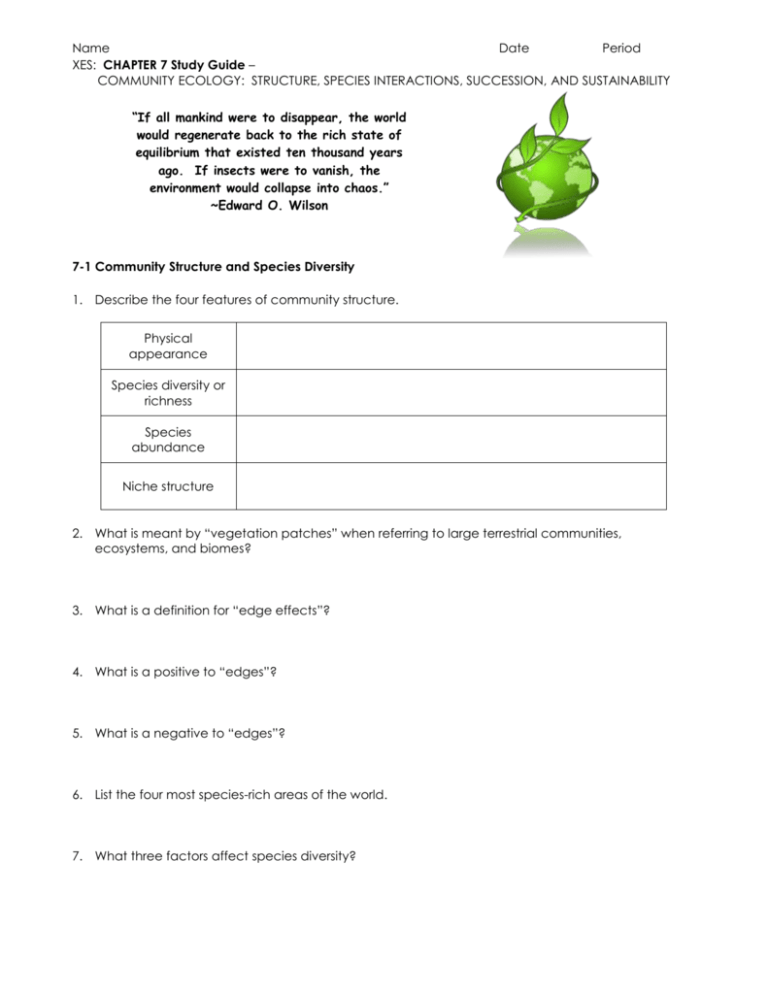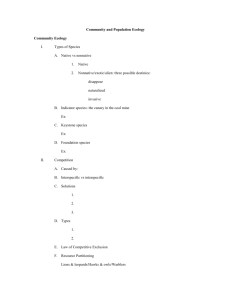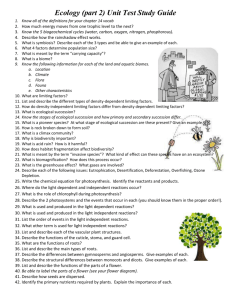Envi Sci @ CHS
advertisement

Name Date Period XES: CHAPTER 7 Study Guide – COMMUNITY ECOLOGY: STRUCTURE, SPECIES INTERACTIONS, SUCCESSION, AND SUSTAINABILITY “If all mankind were to disappear, the world would regenerate back to the rich state of equilibrium that existed ten thousand years ago. If insects were to vanish, the environment would collapse into chaos.” ~Edward O. Wilson 7-1 Community Structure and Species Diversity 1. Describe the four features of community structure. Physical appearance Species diversity or richness Species abundance Niche structure 2. What is meant by “vegetation patches” when referring to large terrestrial communities, ecosystems, and biomes? 3. What is a definition for “edge effects”? 4. What is a positive to “edges”? 5. What is a negative to “edges”? 6. List the four most species-rich areas of the world. 7. What three factors affect species diversity? Name Date Period XES: CHAPTER 7 Study Guide – COMMUNITY ECOLOGY: STRUCTURE, SPECIES INTERACTIONS, SUCCESSION, AND SUSTAINABILITY 7-2 General Types of Species 1. Define and give an example of the four ecological roles species play in an ecosystem. Role Definition Example Native Species Nonnative Species Indicator Species Keystone Species 2. Describe how non-native species can cause problems. Give examples. 3. Why are amphibians vanishing? What does this indicate in the environment? 4. Discuss habitat modifications by a keystone species. 5. What is meant by a “top predator”? Name Date Period XES: CHAPTER 7 Study Guide – COMMUNITY ECOLOGY: STRUCTURE, SPECIES INTERACTIONS, SUCCESSION, AND SUSTAINABILITY 7-3 Species interactions: Competition and Predation 1. What are the five basic types of interactions between species? 2. What is the main difference between intraspecific and interspecific competition? 3. Describe why competition occurs. Define the terms niche and habitat in your understanding of competition. 4. Examine the graph in the space below. Describe how resource partitioning can minimize competition. Recall the discussion of the Tragedy of the Commons. 5. Give two examples of resource partitioning that are described in the book or powerpoint. 6. Describe a predator-prey relationship. 7. Give two examples of predator-prey relationships. 8. Describe the defense and weapons used to survive and give an example of an organism that uses this technique. Predator Weapons Speed Stealth Claw/Fang Prey Defense Characteristics Camouflage Chemical Warfare Warming Coloration Mimicry Behavioral strategies Name Date Period XES: CHAPTER 7 Study Guide – COMMUNITY ECOLOGY: STRUCTURE, SPECIES INTERACTIONS, SUCCESSION, AND SUSTAINABILITY 7-4 Species Interactions: Symbiosis - Parasitism, Mutualism, and Commensalism Mutualism Commensalism Parasitism Species Interactions Definition Physical Difference Between the Host and Parasite/Commensal/Mutual 2 Examples Name Date Period XES: CHAPTER 7 Study Guide – COMMUNITY ECOLOGY: STRUCTURE, SPECIES INTERACTIONS, SUCCESSION, AND SUSTAINABILITY 7-5 Ecological Succession: Communities in Transition 1. What is ecological succession? 2. Describe the difference between primary and secondary succession. Primary Succession Secondary Succession Definition Areas where you would find this type of succession Average time to occur Condition of soil at beginning of succession 3. Disturbances in an ecosystem’s environment can cause an ecological succession to revert. Give several examples of disturbances caused by nature and several caused by humans. 4. An ecological succession’s progress cannot be predicted. Describe why. 7-6 Ecological Stability and Sustainability 5. How is stability maintained in an ecosystem? 6. What three aspects influence stability and sustainability in an ecosystem? 7. What is the precautionary principle, and why do so many scientists find it a useful strategy for dealing with some of the environmental problems we face?









